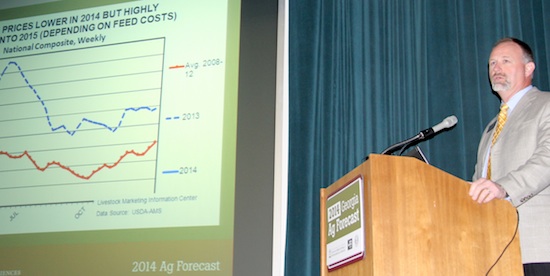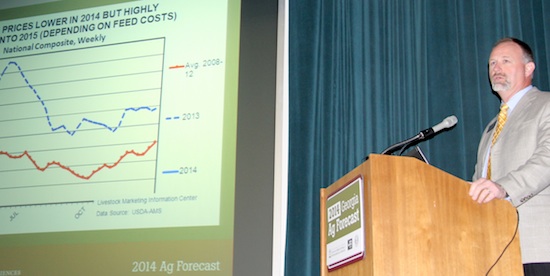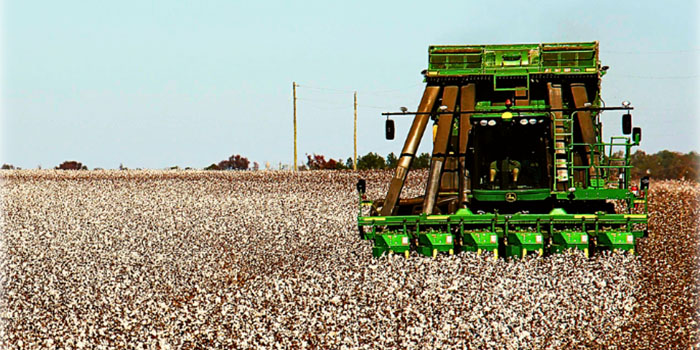Georgia’s livestock producers may see higher profits in 2014 due to lower feed prices and higher consumer demand. However, those lower feed prices, and flat demand for corn for ethanol, may hold down profit margins for Georgia row crop farmers.
University of Georgia experts with the College of Agricultural and Environmental Sciences shared their economic predictions for Georgia’s commodities during Georgia Ag Forecast seminars held across the state Jan. 24 through Jan. 30 in Macon, Athens, Lyons and Bainbridge. Each forecast event focuses most on the commodities grown in that region of the state.
“We have led these ag forecast events for the past seven years to provide farmers and other ag business leaders with the most up-to-date information, so they can prepare for the growing year,” said CAES Dean and Director Scott Angle. “I think it’s a mixed bag this year, depending on the commodity you are working with.”
Despite a small dip in some prices, commodity prices are still reasonably high compared to a few years ago, Angle said.
“In agriculture, we are going to have ups and downs, but overall I feel really good about our industry,” he said. “We are becoming a world player in food production.”
Corn
Corn acres are expected to decrease after Georgia’s second best record yields of 175 bushels per acre in 2013. Georgia acres are expected to drop to below 400,000 in 2014 from last year’s 460,000 harvested acres.
U.S. and worldwide corn supplies are up, and UGA Extension ag economist Nathan Smith expects farmers in the major growing areas of the Midwest to switch some corn acreage to soybeans.
Corn grown for ethanol use has “leveled off,” and domestic use has increased, Smith said. “Overall ethanol profit margins are higher, but corn will need some growth in the fuel market besides feed use and export,” he said.
Peanuts
Peanut acreage will likely be up this year compared to last, but exports will be down.
“There was a 38 percent decline in Georgia peanut acreage in 2013 due to higher prices in cotton and corn. More farmers switched to these crops,” said Smith. “This year will be more representative of a normal cycle.”
Demand for peanut butter was hurt when retail prices were raised in 2012, but consumption should rebound. Candy and snack consumption should lead growth in domestic peanut usage, Smith said.
Soybeans/Wheat
“Grain and soybean growers have enjoyed a good run of prices since 2007. However, the run appears to be over as U.S. and foreign producers have recovered from short production years,” Smith said. Soybean and wheat prices are expected to fall in 2014.
Soybean acres and exports are expected to increase, but exports will slow down once China begins buying soybeans from Brazil, he said. “The U.S. and Brazil grow about the same size crop. South America is our big competitor for soybeans going to the export market,” Smith said. “We may grow a few more acres in the U.S. this year and maybe a few more in Georgia.”
Due to lower prices, wheat acreage in Georgia will likely decrease to 270,000 acres – down from 420,000 in 2013.
Cotton
UGA Extension cotton economist Don Shurley says world demand for cotton is “improving slowly.” He expects production in Georgia to increase slightly in 2014.
“Cotton and peanuts are the two large crops in Georgia. The price of cotton may be down a little bit this year, compared to where we were this past year, so profit margins are going to be tighter,” Shurley said. “The good news is that fertilizer is going to be a little bit cheaper, but diesel fuel is still very expensive and farmers are still going to pay a lot for chemicals.”
Dairy
Georgia dairymen can expect to see a “slight improvement” in prices and an increase in exports to China and the Pacific Rim. Georgia farmers produce more milk now from fewer cows. Lower feed prices mean they should end the year with a profit for a change, said UGA Extension livestock economist Curt Lacy.
Some 240 Georgia dairies are collectively expected to produce about 1.55 billion pounds of milk this year. Since 2010, milk production per cow has increased nearly 10 percent through efficiency gains.
Beef
Beef producers are also expected to fare well this year, too, since herd sizes are smaller. A decline is expected in total red meat production, including veal and lamb.
Unfortunately for cattlemen, the economy directly impacts the demand for beef and other protein products, Lacy said. Consumers have more disposable income to spend on groceries than they did a few years ago, but still not as much as they did before 2008.
“The reality is that most folks don’t have any more disposable income than they did six or seven years ago due to higher taxes, higher fuel prices and other expenses,” he said. “It’s really hard to push higher prices on to consumers at the retail level because they don’t have any more to spend.”
Pork
UGA experts expect pork producers to continue to struggle as they have the last several years. “Pork prices were high (last year), but feed costs were, too, and farmers couldn’t overcome that,” Lacy said.
Farmers are also battling porcine epidemic diarrhea virus – a highly contagious virus that is deadly to piglets. Confirmed in 22 states, but not in Georgia, the virus appeared last April and could reduce domestic pork production by 2 to 3 percent, Lacy said. It poses no threats to human health or food safety.
Poultry
Georgia poultry farmers are expected to produce more broilers this year. About 20 percent of those birds will go overseas. Georgia once sold most of its exported poultry to Russia, where a fledgling poultry industry is now being developed. Georgia’s excess broilers will likely be headed to countries in Africa, Asia and Europe, said UGA Center for Agribusiness and Economic Development Director Kent Wolfe.
With corn prices leveling off this year, poultry producers may see larger profits this year. The industry in general is on track to grow by about 3 percent, he added.
Miscellaneous
Honey prices are expected to rise this year and next, as the number of hives decline in Georgia
Overall demand for timber should pick up as international demand increases. The popularity of wood pellets for burning also continues to increase.
Farmers may experience sticker shock on expenditures like farm tractors and self-propelled combines/harvesters, but UGA experts say the value of disposable inputs (seed, fuel, feed, fertilizer, chemicals and animal health products) will remain in check.
The forecast events for Cartersville and Tifton were postponed due to the winter snowstorm that hit Georgia on Jan. 28.





